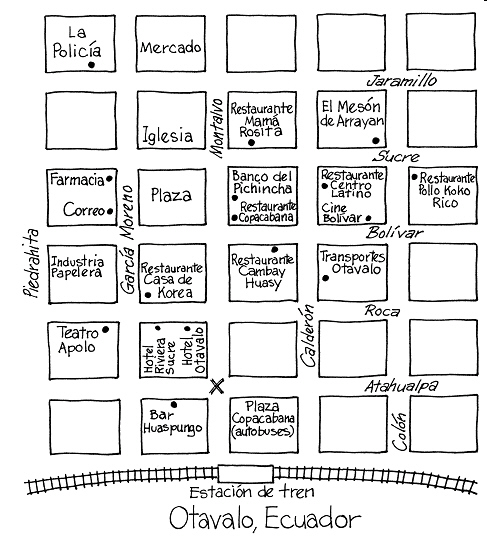¿Me puededar...? Inés needs to buy food at the market. The diagram below shows the distance between Inés and the different items. Fill in the blanks with the correct demonstrative adjectives or pronouns, according to the diagram. Follow the model.
MODELO: ¿Me puede dar esaleche?

1. Deme una bolsa de ____________ papitas fritas, por favor.
2. Quisiera tres kilos de __________ salchichas.
3. Necesito queso. Demeun kilo de __________ de aquí.
4. ¿Me puede dar también una docena de __________huevos, por favor?
5. Necesito un kilo de pollo. ¿Está fresco __________?
6. ¿Qué tal está _________ yogur? ¿Está rico?
7. ¿Cuántocuestan_________ vegetales?
8. Quiero un jamón. ¿Me da _________, por favor?
1. esas
2. aquellas
3. este
4. estos
5. aquel
6. ese
7. estos
8. aquel
You might also like to view...
La professoressa ha già parlato di Dante* alla classe*?
Rispondete alle domande usando i pronomi doppi. (Answer the questions using double object pronouns.)
Read the selection below and answer the questions that follow by choosing the letter of the correct answer.
Skunked My mother told me about a family vacation which ended up causing quite a stink. Her father purchased an old hunting cabin which faced the Great Sacandaga Lake in New York State. It took a little less than two hours for the family to drive there which made it the perfect weekend getaway in the summertime, and it usually was perfect for little Karla and her parents. The cabin was perched on a wooded hillside facing the lake. She could walk outside and look at the beautiful lake surrounded by mountains. When she was taking out her clothes from her duffle to put into the dresser in the cabin, she dropped her shoe and could hear a scurrying sound, and then smelled a terrible odor. “Yuck!” She yelled. Her father smelled it too, and said it was a skunk. Just as the smell was less intense, her mother moved the table which brushed up against a picture on the wall of a deer which fell with a “thud.” Again, the stench arose from the floor. All they could figure out was that at least one skunk was living underneath the cabin. The whole family walked around on tiptoes trying not to upset the rodent residents below the rest of their week in the woods. Eventually Karla’s father was able to get rid of the skunks. He traveled to the cabin by himself one weekend and came back exhausted, and also pretty smelly. 1. Where were the skunks living? a. Outside in the woods b. Underneath the floor of the cabin. c. Next to the water. d. Behind the table. 2. How long did it take her family to drive to the cabin? a. 1 hour b. Slightly under 2 hours c. 3 hours d. 4 hours 3. When did the skunks spray their odor? a. All night b. Only when someone dropped something on the floor c. Every two hours d. Once in the morning 4. Where was the cabin located? a. On Lake Erie b. On the Great Sacandaga Lake in New York c. At the New Jersey shore d. In St. Paul, Minnesota 5. Who was able to get rid of the skunks? a. Her father b. Her mother c. A friend d. They weren’t able to get rid of the skunks. 6. Why do you think the skunks sprayed their odor? a. Because they were hungry b. Because they were scared of the noises they heard. c. Because an animal was hunting them. d. Because they were sick.
COMPRENSIÓN AUDITIVA ¿Para ir a …? Varios turistas visitan Otavalo, Ecuador, pero necesitan pedir información para llegar a diferentes lugares. Escucha los diálogos con el agente de policía para saber adónde van, como en el modelo. (¡OJO! The police agent is standing in X.) Click here for audio. Modelo: (You hear) "Siga por esta calle, la calle Montalvo, por una cuadra. En la primera esquina, doble a la derecha en la calle Roca. Siga una cuadra por esa calle y doble a la izquierda en la siguiente esquina. Está a la derecha." (You write) ¿Para ir a Transportes Otavalo?¿Para ir a
Modelo: (You hear) "Siga por esta calle, la calle Montalvo, por una cuadra. En la primera esquina, doble a la derecha en la calle Roca. Siga una cuadra por esa calle y doble a la izquierda en la siguiente esquina. Está a la derecha." (You write) ¿Para ir a Transportes Otavalo?¿Para ir a
________________________________________________________? What will be an ideal response?
Being testwise
A) can lead to improved scores on tests. B) means using test-taking tricks and shortcuts. C) includes cramming before tests.